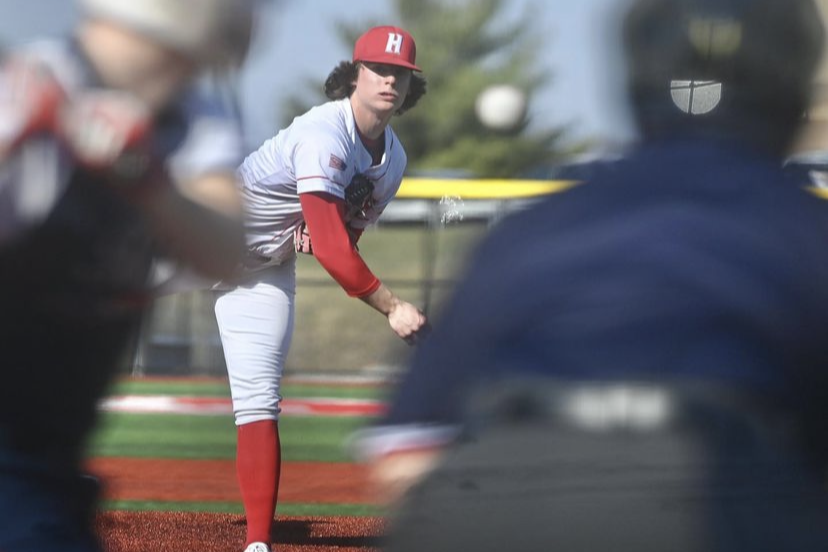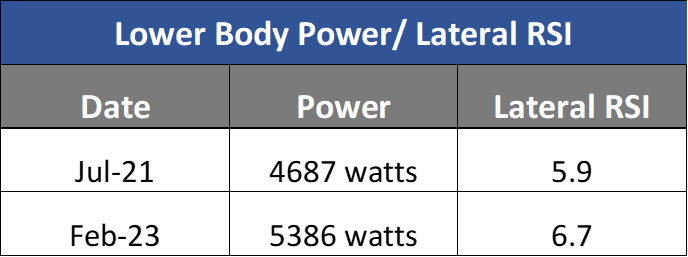
Brett Antolick (Texas A&M commit, Class 2023) started training with us on a remote basis almost two years ago, beginning in July of 2021. At the time, he came to RPP at the recommendation of Nate Yeskie, the Texas A&M Pitching Coach. Although Brett trains on a remote basis, luckily, he doesn’t live too far and during this time period he has been able to perform his assessments and reassessments in-house. Shortly after he first started, he was clocked sitting 86-87 and touching 88 (at PBR-PA). Fast forward to April 2023, at a high school outing recently he was sitting 91-94 and touching 95 mph. How did he do it?
The Game Plan
When Brett first showed up at RPP for his assessment in 2021, he was 16 and already a strong high school pitcher at 6’3” weighing in at 194 lbs. But he needed to get more athletic in both his strength and movement quality to compete at the next level. Increasing Brett’s strength as well cleaning up his movement strategies would also go a long way in helping to better address some lower half issues in his pitching mechanics. Let’s take a look at the blueprint over the past two years.
Increasing Lean Body Mass
We knew that increasing Brett’s physical size (weight) while reducing body fat % would help him move more explosively. The results below highlight this transition and are essentially like putting a bigger engine into a car to achieve more horsepower. From July 2021 through this past February, he added over 20 lbs. of weight while reducing his LBM% by 7 points.

Improving Mobility
On the mobility side of things, we had to address Brett’s extremely tight lats that were contributing to him having a low shoulder at foot plant and causing a bit of an “uphill” throw as well as a slightly late arm (flyout). As far as the lower half, Brett presented with very little hip ER as well as poor ankle mobility. Both of these needed to be addressed to help him better load his posterior chain when coming down the mound and continuing to rotate into and after release to create a better decel pattern and prevent his arm from slamming shut.
Improving Strength
Brett had a fairly good amount of strength when he arrived here but had an average power output in his multi-planar power testing. Due to the fact that he tested well on his reactive (plyometric) ability, we knew that increasing strength numbers would be where we needed to focus in order to get those power numbers up. Below are his strength and power results over this time period:


Note: During this period, Brett underwent knee surgery but continued to work out the rest of his body, much like we do with our TJ athletes. This is reflected in approximately 15% gains in strength and power even through a 6-month layoff of using the left (lead) leg.
Addressing Mechanical Disconnects
During Brett’s initial visit, Brett was evaluated with both video and motion capture analysis. Although video is always a must when reviewing a pitcher’s delivery, the motion capture data allows us to review things that we can’t see with the naked eye. In essence, it allows us to go deeper.
Brett had a very athletic delivery even during his baseline throwing assessment, but even still, we thought that addressing a few disconnects could help him reach a higher velocity ceiling as well as improving his overall ball movement. We worked on 2-3 drills at a time, beginning with patterns that occur earlier in his delivery as this is usually what sets inefficient patterns off later downstream. We also started biasing his back foot into IR at set up to take his lack of ER into account.
Arm/Shoulder – The following disconnects were highlighted during the review:
-
- Low shoulder/elbow flexion – Otherwise known as forearm flyout, can cause unnecessary stress on the UCL and anterior shoulder while making it hard to get into lay-back.
- Shoulders level at foot plant – We call this throwing “uphill” and can negatively affect the ability to get better leverage on the ball in order to create later arm speed as well as better vert break.
- Glove side integrity – Turning the glove side over early can make it difficult to keep the upper half closed longer as well as the ability to rotate “down” into landing.
Lower Half – The following disconnects were highlighted during the review:
-
- Pelvic / glute engagement / timing – This is defined by proper weight distribution on the back foot/leg as well as hinging at the hips in order to avoid a push into landing.
- Knee ext. angular velocity – The ability to decelerate and the speed at which the knee / leg extends, when blocking is a main player in facilitating hip and ultimately torso rotation up the chain. It also has one of the highest correlations to velocity.
- Continued rotation around front hip – Rotating down and around the front hip allows the pitcher to “buy more time” while avoiding a rapid slam on the posterior cuff and stress on the medial elbow.
Below is a list of some of the drills we used and the patterns they helped to correct. It’s important to realize that drills alone will generally not correct a mechanical issue but along with improving strength and mobility is a part of the plan.
-
- Walking Torques – Glove side integrity and hip / shoulder separation)
- Step Back Throw – Help feel lower half load / move COM more linear to avoid low shoulder at FP
- Step Behind – Help get upper half moving a bit sooner while delaying upper half
Summary
When it comes to getting buy-in from an athlete, no one fits the bill better than Brett. His commitment to the programming and his diligence in staying in contact with his performance coaches (even through his surgery), as well as his willingness to drive to us to get assessed in person speaks volumes about this young man. I think this is very evident through the progress he has made since he started his training. Brett’s velo is up 6-7 mph, since he started training with us and as I mentioned earlier he’s touched 95. Even better, his performance on the mound is just as good, including two back-to-back no-hitters recently.
By Nunzio Signore
You live too far to train with us in-house at RPP? You can now train with us on a REMOTE basis.


